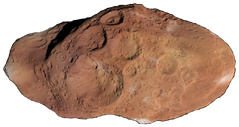| Amalthea | |
|---|---|

| |
| Name of satellite | Amalthea |
| Date of discovery | September 9, 1892 |
Amalthea, also known as Jupiter V, is an irregular-shaped prograde satellite belonging to the planet of Jupiter. It was discovered on September 9, 1892 by Edward Emerson Barnard. It is located on one of Jupiter's rings called the Amalthea Gossamer Ring, which it is a main supplier of.
Amalthea is the reddest object in the solar system. It is even redder than that of the Carme grouped-moon, Kalyke. This is due to Amalthea giving out more heat than it receives from the Sun. This is possibly due to Amalthea's electrically charged core, due to it being so close to Jupiter's magnetic field.
Amalthea makes up its own group known as the Amalthea group.
Composition
Amalthea is thought to consist of porous ice water under the surface, yet the ocean is too deep for astronomers to comprehend or spot. Astronomers believe that the icy ocean is too deep for any life to survive or thrive.
Surface
The surface of Amalthea is reddish, possibly due to sulfur from neighboring moon, Io, or other Galilean moons of Jupiter. With a surface brighter than those of the inner satellites of Jupiter, Amalthea has green patches on the surface, yet the nature or origin is currently unknown by astronomers. The surface is full of craters from previous impacts and collisions with other minor moons.
Geographical Features
Orbit/Rotation
Due to Amalthea, along with the neighboring moon, Thebe, making one rotation on its axis in correspondence to making one orbit around Jupiter (in approximately one-third of an Earthen day), only one side of Amalthea faces Jupiter.